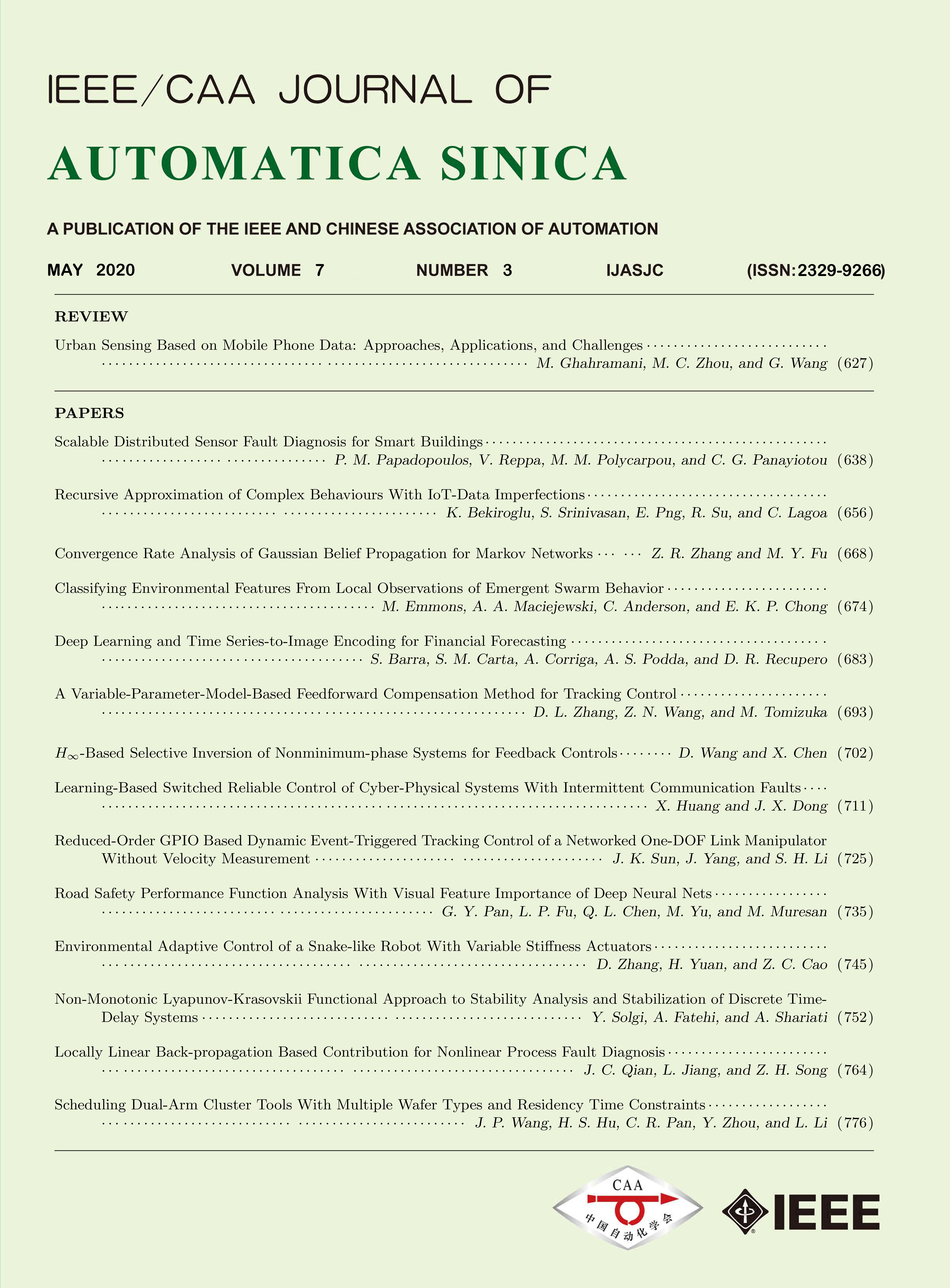 Volume 7
Issue 3
Volume 7
Issue 3
IEEE/CAA Journal of Automatica Sinica
| Citation: | Megan Emmons, Anthony A. Maciejewski, Charles Anderson and Edwin K. P. Chong, "Classifying Environmental Features From Local Observations of Emergent Swarm Behavior," IEEE/CAA J. Autom. Sinica, vol. 7, no. 3, pp. 674-682, May 2020. doi: 10.1109/JAS.2020.1003129 |

| [1] |
I. Navarro and F. Matía, “An introduction to swarm robotics,” Int. Scholarly Research Notices Robotics, vol. 2013, 2012. doi: 10.5402/2013/608164
|
| [2] |
R. L. Sturdivant and E. K. P. Chong, “The necessary and sufficient conditions for emergence in systems applied to symbol emergence in robots,” IEEE Trans. Cognitive and Developmental Systems, vol. 10, no. 4, pp. 1035–1042, Dec. 2018. doi: 10.1109/TCDS.2017.2731361
|
| [3] |
M. Emmons, A. A. Maciejewski, and E. K. P. Chong, “Modelling emergent swarm behavior using continuum limits for environmental mapping,” in Proc. IEEE Int. Conf. Control and Automation, Jun. 2018, pp. 86–93.
|
| [4] |
C. A. C. Parker and H. Zhang, “Cooperative decision-making in decentralized multiple-robot systems: the best-of-n problem,” IEEE/ASME Trans. Mechatronics, vol. 14, no. 2, pp. 240–251, Apr. 2009. doi: 10.1109/TMECH.2009.2014370
|
| [5] |
J. T. Ebert, M. Gauci, and R. Nagpal, “Multi feature collective decision making in robot swarms,” in Proc. 17th Int. Conf. Autonomous Agents and Multiagent Systems, Jul. 2018.
|
| [6] |
M. Schneider-Fontan and M. J. Mataric, “Territorial multi-robot task division,” IEEE Trans. Robotics and Automation, vol. 14, no. 5, pp. 815–822, Oct. 1998. doi: 10.1109/70.720357
|
| [7] |
B. P. Gerkey and M. J. Matarić, “A formal analysis and taxonomy of task allocation in multi-robot systems,” The Int. J. Robotics Research, vol. 23, no. 9, pp. 939–953, 2004. doi: 10.1177/0278364904045564
|
| [8] |
M. J. Matarić, G. S. Sukhatme, and E. H. Østergaard, “Multi-robot task allocation in uncertain environments,” Autonomous Robots, vol. 14, no. 2, pp. 255–263, Mar. 2003.
|
| [9] |
D. Fox, W. Burgard, H. Kruppa, and S. Thrun, “A probabilistic approach to collaborative multi-robot localization,” Autonomous Robots, vol. 8, no. 3, pp. 325–344, Jun. 2000. doi: 10.1023/A:1008937911390
|
| [10] |
A. Prorok, A. Bahr, and A. Martinoli, “Low-cost collaborative localization for large-scale multi-robot systems,” in Proc. IEEE Int. Conf. Robotics and Automation, May 2012, pp. 4236–4241.
|
| [11] |
J. Chen, K. H. Low, Y. Yao, and P. Jaillet, “Gaussian process decentralized data fusion and active sensing for spatiotemporal traffic modeling and prediction in mobility-on-demand systems,” IEEE Trans. Automation Science and Engineering, vol. 12, no. 3, pp. 901–921, Jul. 2015. doi: 10.1109/TASE.2015.2422852
|
| [12] |
A. Giusti, J. Nagi, L. Gambardella, and G. A. D. Caro, “Cooperative sensing and recognition by a swarm of mobile robots,” in Proc. IEEE/RSJ Int. Conf. Intelligent Robots and Systems, Oct. 2012, pp. 551–558.
|
| [13] |
K. H. Low, W. K. Leow, and J. Marcelo H. Ang, “Autonomic mobile sensor network with self-coordinated task allocation and execution,” IEEE Trans. Systems,Man,and Cybernetics,Part C (Applications and Reviews)
|
| [14] |
S. Bandyopadhyay, S.-J. Chung, and F. Y. Hadaegh, “Probabilistic and distributed control of a large-scale swarm of autonomous agents,” IEEE Trans. Robotics, vol. 33, no. 5, pp. 1103–1123, Oct. 2017. doi: 10.1109/TRO.2017.2705044
|
| [15] |
A. Dirafzoon and E. Lobaton, “Topological mapping of unknown environments using an unlocalized robotic swarm,” in Proc. IEEE/RSJ Int. Conf. Intelligent Robots and Systems, pp. 5545–5551, Nov. 2013.
|
| [16] |
S. Levine, P. Pastor, A. Krizhevsky, J. Ibarz, and D. Quillen, “Learning hand-eye coordination for robotic grasping with deep learning and largescale data collection,” The Int. J. Robotics Research, vol. 34, no. 4–5, pp. 421–436, 2018.
|
| [17] |
J. Morelli, P. Zhu, B. Doerr, R. Linares, and S. Ferrari, “Integrated mapping and path planning for very large-scale robotic (vlsr) systems,” in Proc. Int. Conf. Robotics and Automation, May 2019, pp. 3356–3362.
|
| [18] |
L. Hou, F. Fan, J. Fu, and J. Wang, “Time-varying algorithm for swarm robotics,” IEEE/CAA J. Autom. Sinica, vol. 5, no. 1, pp. 217–222, Jan. 2018. doi: 10.1109/JAS.2017.7510685
|
| [19] |
S. Berman, V. Kumar, and R. Nagpal, “Design of control policies for spatially inhomogeneous robot swarms with application to commercial pollination,” in Proc. IEEE Int. Conf. Robotics and Automation, May 2011, pp. 378–385.
|
| [20] |
K. Elamvazhuthi, H. Kuiper, and S. Berman, “PDE-based optimization for stochastic mapping and coverage strategies using robotic ensembles,” Automatica, vol. 95, pp. 356–367, Sept. 2018. doi: 10.1016/j.automatica.2018.06.007
|
| [21] |
L. E. Barnes, M. A. Fields, and K. P. Valavanis, “Swarm formation control utilizing elliptical surfaces and limiting functions,” IEEE Trans. Systems,Man,and Cybernetics,Part B, vol. 39, no. 6, pp. 1434–1445, Dec. 2009. doi: 10.1109/TSMCB.2009.2018139
|
| [22] |
F. Mondada, M. Bonani, X. Raemy, J. Pugh, C. Cianci, A. Klaptocz, S. Magnenat, J.-C. Zufferey, D. Floreano, and A. Martinoli, “The e-puck, a robot designed for education in engineering,” in Proc. 9th Conf. Autonomous Robot Systems and Competitions, vol. 1, no. 1, pp. 59–65, 2009. [Online]. Available: http://infoscience.epfl.ch/record/135236
|
| [23] |
F. Mondada, E. Franzi, and P. Ienne, “Mobile robot miniaturisation: a tool for investigation in control algorithms,” Experimental Robotics III, vol. 200, pp. 501–513, 2009.
|
| [24] |
M. Rubenstein, C. Ahler, and R. Nagpal, “Kilobot: a low cost scalable robot system for collective behaviors,” in Proc. IEEE Int. Conf. Robotics and Automation, May 2012, pp. 3293–3298.
|
| [25] |
C. M. Bishop, Pattern Recognition and Machine Learning. Springer, 2013.
|
| [26] |
B. Yamauchi, “A frontier-based approach for autonomous exploration,” in Proc. Int. Symp. Computational Intelligence in Robotics and Automation, Jul. 1997, pp. 146–151.
|